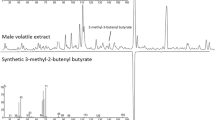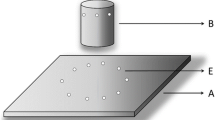Abstract
Cyrtomon luridus (Boheman) (Coleoptera: Curculionidae: Entiminae) is a serious pest of Duboisia sp. (Solanaceae) in Brazil. However, our knowledge of the reproductive behavior and the chemical ecology of this curculionid is based on very limited data. The aim of this study was therefore to describe the mating behavior of C. luridus and the olfactory response of males and females to volatiles of conspecifics alone or conspecifics with a host plant. The mating behavior was observed in newly emerged pairs for 9 days in the laboratory. A Y-tube olfactometer was used to evaluate the responses of beetles to odor sources. The paired adults began to mate 2 days after emergence, and they displayed repeated matings that increased in frequency with age. The males were the most active sex in the mating system of C. luridus. The mating sequence in this species was divided into precopulatory, copulatory and postcopulatory phases. In the olfactometer bioassays, the volatiles emitted from males that fed on Duboisia sp. were attractive to conspecific weevils. The evidence from this result indicates that chemical communication in C. luridus is likely mediated by an aggregation pheromone produced by males. Our findings provide new insights into the mating system and chemical ecology of C. luridus and may serve as a foundation for future studies to develop strategies for the management of this curculionid in the field.





Similar content being viewed by others
References
Alcock J (1994) Postinsemination associations between males and females in insects: the mate-guarding hypothesis. Annu Rev Entomol 39:1–21
Ambrogi BG, Zarbin PHG (2008) Aggregation pheromone in Sternechus subsignatus (Coleoptera: Curculionidae): olfactory behaviour and temporal pattern of emission. J Appl Entomol 132:54–58
Bartelt RJ (1999) Weevils. In: Hardie J, Minks AK (eds) Pheromones of non-lepidopteran insects associated with agricultural plants. CABI Publishing, Wallingford, pp 91–112
Benelli G, Meregalli M, Canale A (2014) Field observations on the mating behavior of Aclees sp. cf. foveatus Voss (Coleoptera: Curculionidae), an exotic pest noxious to fig orchards. J Insect Behav 27:419–427
Birch MC (1978) Chemical communication in pine bark beetles. Am Sci 66:409–419
Blight MM, Wadhams LJ (1987) Male-produced aggregation pheromone in pea and bean weevil, Sitona lineatus (L). J Chem Ecol 13:733–739
Blight MM, Pickett JA, Smith MC, Wadhams LJ (1984) An aggregation pheromone of Sitona lineatus. Naturwissenschaften 71:480
Dickens JC (1989) Green leaf volatiles enhance aggregation pheromone of boll weevil, Anthonomus grandis. Entomol Exp Appl 52:191–203
Goel MK, Khanna P, Kishore J (2010) Understanding survival analysis: Kaplan-Meir estimate. Int J Ayurveda Res 1:274–278
Gwynne DT (2003) Mating behavior. In: Resh VH, Cardé RT (eds) Encyclopedia of insects. Academic, San Diego, pp 682–688
Harari AR, Handler AM, Landolt PJ (1999) Size-assortative mating, male choice and female choice in the curculionid beetle Diaprepes abbreviatus. Anim Behav 58:1191–1200
Harari AR, Landolt PJ, O’Brien CW, Brockmann HJ (2003) Prolonged mate guarding and sperm competition in the weevil Diaprepes abbreviatus (L.). Behav Ecol 14:89–96
Jaffé K, Sánchez P, Cerda H, Hernández JV, Jaffé R, Urdaneta N, Guerra G, Martínez R, Miras B (1993) Chemical ecology of the palm weevil Rhynchophorus palmarum (L.) (Coleoptera: Curculionidae): attraction to host plants and to a male-produced aggregation pheromone. J Chem Ecol 19:1703–1720
Lanteri AA (1990) Revisión sistemática del género Cyrtomon Schönherr (Coleoptera, Curculionidae). Rev Bras Entomol 34:387–402
Lapointe SL, Alessandro RT, Robbins PS, Khrimian A, Svatos A, Dickens JC, Otálora-Luna F, Kaplan F, Alborn HT, Teal PE (2012) Identification and synthesis of a male-produced pheromone for the neotropical root weevil Diaprepes abbreviatus. J Chem Ecol 38:408–417
LeCato GL, Pienkowski RL (1970) Laboratory mating behavior of the alfalfa weevil, Hypera postica. Ann Entomol Soc Am 63:1000–1007
Morrone JJ (1999) The species of Entiminae (Coleoptera: Curculionidae) ranged in America south of the United States. An Inst Biol UNAM Ser Zool 76:99–168
Mutis A, Parra L, Palma R, Pardo F, Perich F, Quiroz A (2009) Evidence of contact pheromone use in mating behavior of the raspberry weevil (Coleoptera: Curculionidae). Environ Entomol 38:192–197
Parker GA (1974) Courtship persistence and female-guarding as male time investment strategies. Behaviour 48:157–184
Polak M, Brown WD (1995) Mating tactics and courtship behavior in Cleogonus rubetra (Fabricius) (Coleoptera, Curculionidae). J Insect Behav 8:453–463
R Development Core Team (2012) R: a language and environment for statistical computing. R Foundation for Statistical Computing, Vienna
Ruíz-Montiel C, Rojas JC, Cruz-Lopez L, Gonzalez-Hernandez H (2009) Factors affecting pheromone release by Scyphophorus acupunctatus (Coleoptera: Curculionidae). Environ Entomol 38:1423–1428
Silva WD, Mascarin GM, Romagnoli EM, Bento JMS (2012) Mating behavior of the coffee berry borer, Hypothenemus hampei (Ferrari) (Coleoptera: Curculionidae: Scolytinae). J Insect Behav 25:408–417
Sirot LK, Brockmann HJ, Lapointe SL (2007) Male postcopulatory reproductive success in the beetle, Diaprepes abbreviatus. Anim Behav 74:143–152
Thornhill R, Alcock J (1983) The evolution of insect mating systems. Harvard University Press, Cambridge
Tironi P, von Treuenfels A, Parra JRP (2005) Population dynamics of Cyrtomon luridus Boheman (Coloptera: Curculionidae) on Duboisia sp. (Solanaceae) in Brazil. Sci Agric 62:473–477
Unelius CR, Park KC, McNeill M, Wee SL, Bohman B, Suckling DM (2013) Identification and electrophysiological studies of (4S,5S)-5-hydroxy-4-methyl-3-heptanone and 4-methyl-3,5-heptanedione in male lucerne weevils. Naturwissenschaften 100:135–143
Vanderbilt CF, Giblin-Davis RM, Weissling TJ (1998) Mating behavior and sexual response to aggregation pheromone of Rhynchophorus cruentatus (Coleoptera: Curculionidae). Fla Entomol 81:351–360
Weissling TJ, Giblin-Davis RM, Gries G, Gries R, Perez AL, Pierce HD, Oehlschlager AC (1994) Aggregation pheromone of palmetto weevil, Rhynchophorus cruentatus (f.) (Coleoptera: Curculionidae). J Chem Ecol 20:505–515
Acknowledgments
We would like to thank the Coordenação de Aperfeiçoamento de Pessoal de Nível Superior (CAPES), the Fundação de Amparo à Pesquisa do Estado de São Paulo (FAPESP), INCT Semioquímicos na Agricultura (FAPESP/CNPq), and Boehringer Ingelheim for the financial support provided for this work. We are also grateful to Marcelo Kauffman Filho and Ricardo Luis Duarte for their help in the collection of the biological materials.
Author information
Authors and Affiliations
Corresponding author
Rights and permissions
About this article
Cite this article
Kamiya, A.C., Silva, W.D., Leite, M.O.G. et al. Mating Behavior and Evidence for Male-Produced Aggregation Pheromone in Cyrtomon luridus (Boheman) (Coleoptera: Curculionidae: Entiminae). J Insect Behav 28, 55–66 (2015). https://doi.org/10.1007/s10905-014-9481-1
Revised:
Accepted:
Published:
Issue Date:
DOI: https://doi.org/10.1007/s10905-014-9481-1




